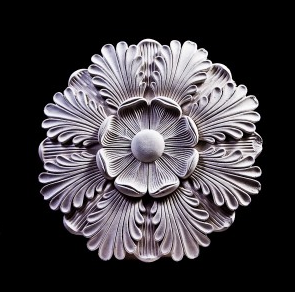The Origins of English Decorative Plaster
Most of the features of decorative plaster used in England can be dated to the English Renaissance of the 16th and 17th centuries. Visitors to Italy had been able to admire the Renaissance decoration there, including styles like Marmorino and Montovano, which are still used to this day.
Decorative plaster was used to adorn many of the palaces of Henry VIII, and although there had been previous attempts at decorating ceilings, particularly carved timber ceilings in churches and in Windsor Castle, the reign of Henry VIII really saw the first use of plaster as decoration in England.
Early 16th century designs began as hexagonal blocks, perhaps relating to the Spanish history of Henry VIII’s first wife, but these soon faded out of popularity, and it became more common to mix timber beams with plaster to create a black work effect, resembling the lacework of the same period. Plaster in between the timber was often decorated with heraldic motifs and coloured panels.
This could be guilded as well as coloured, and it was certainly painted with greens, blues and reds for a most striking appearance.
Renaissance Designs
In the later Renaissance period, plaster ceilings were often decorated with coloured areas, and divided into fields in what is known as a ‘curvilinear rib’ pattern. The example in Charterhouse features gold coils with leaf patterns, heraldic lions and a coat of arms. Slightly later in build, the plaster frieze in the long gallery of Ormond Castle depicts classical figures in archways, along with a large bust-figure of Elizabeth I.
This decoration is highly intricate, and very detailed. It resembles the plaster decoration of the early Renaissance period, but is much more complex and decorated.
Inigo Jones
One of the leaders of Royal decorative plasterwork was Inigo Jones. His work in the Queens House in Greenwich helped to establish the patterns, which are still used in England today. Decorative examples of his work, taken from his travels to Italy, include garlands depicted in Ham House, copied from Jones by Kinsman in the 1630s. Transitional ceilings also followed these traditions, including buildings in Highgate, and other large buildings in London.
Nineteenth Century Plasterwork
By the start of the Nineteenth century, tastes in decoration were changing. The desire for lighter and more delicate patterns was emerging, in contrast to the heavy patterns of previous centuries. Decorative plaster was changed by the invention in 1851 of gelatine moulds, which allowed more delicate moulding of the plaster, and the creation in 1856 of fibre plaster, which allowed workers to use lighter plaster, which was also more durable.
This meant that decorative work could take place in a much smaller area, but with much more detailing.
Now, much of the plasterwork created by the Victorians needs to be restored. A lot of it is tired and fading, and there can also be cracking of the plaster due to the materials used. When this type of problem occurs, restoration needs to be done by experienced plaster restorers.
Dominic Farrugia is the Co-Director of Regency Plaster which offers a professional plaster restoration service in Enfield, London and across the UK
